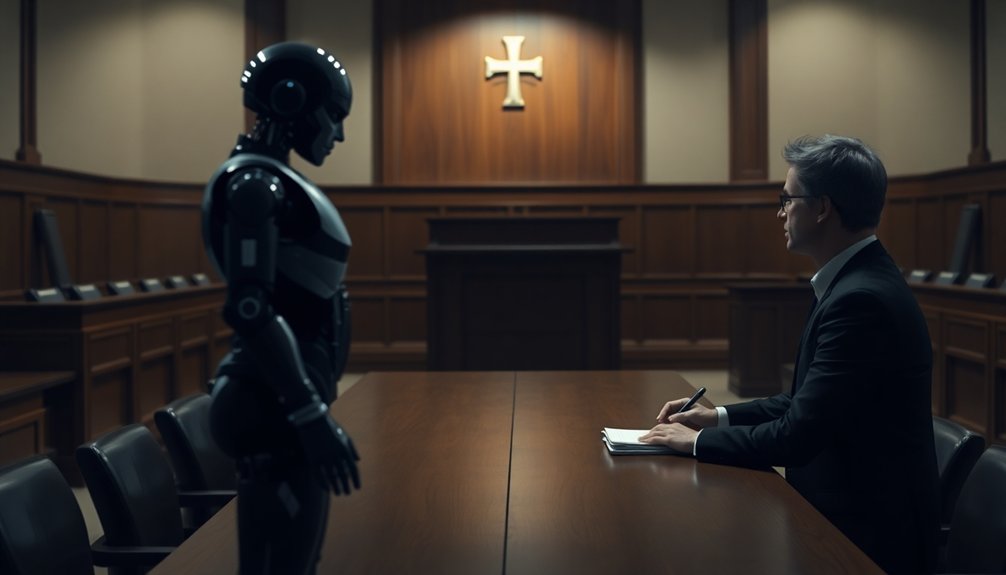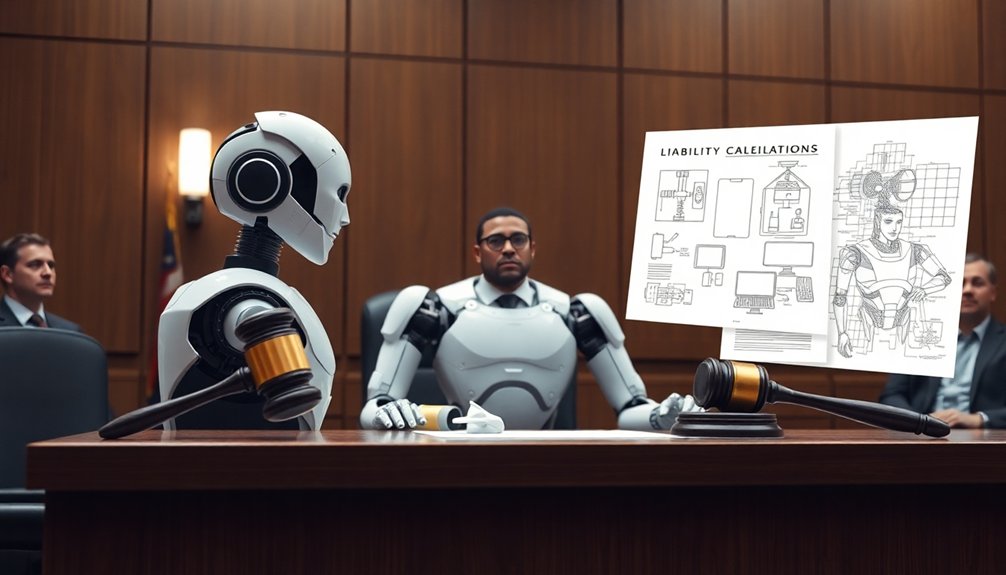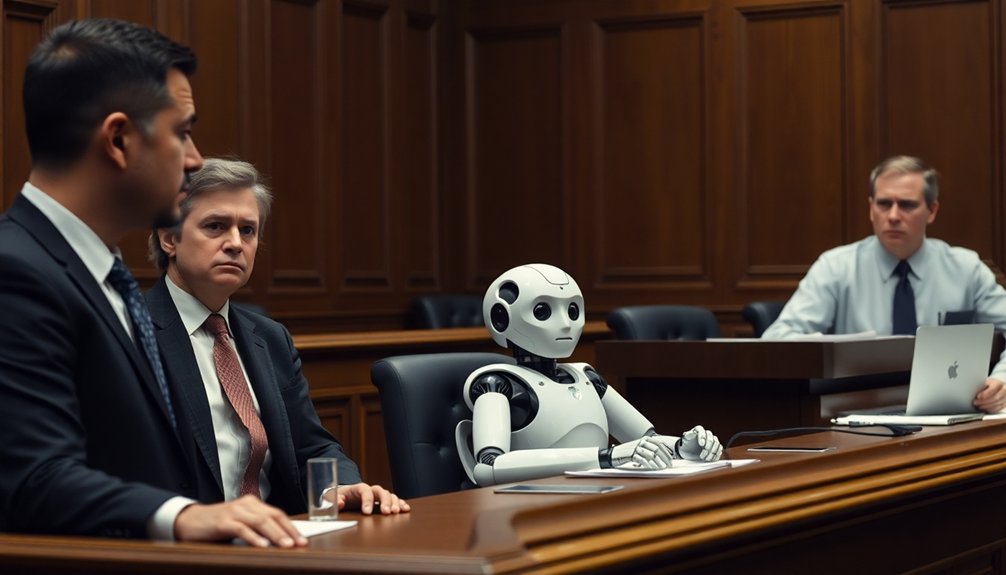When robots mess up, you’ll likely blame the company, not the machine. Turns out, people are weirdly forgiving of robotic slip-ups, shifting responsibility to organizations behind the tech. Whether it’s a customer service bot or a healthcare robot, consumers see machines as tools, not true agents. Legal frameworks are scrambling to catch up, but for now, the buck stops with the manufacturer. Curious how this blame game will evolve?
The Shifting Landscape of Technological Accountability

While robots were once the stuff of science fiction, they’re now showing up everywhere from customer service desks to surgical theaters—and they’re not always getting things right. Neural network architectures struggle with complex real-world scenarios, introducing additional layers of uncertainty in technological accountability. As AI capabilities expand, we’re wrestling with who’s truly responsible when technology goes sideways. Should legal personhood be granted to AI systems? Can robots be held accountable, or do companies bear the liability? These ethical issues become more complex as technology advances. You might think a malfunctioning robot is just a glitch, but it’s actually a profound accountability puzzle. Imagine a surgical robot that makes a mistake—who takes the blame? The programmer? The manufacturer? The healthcare system? The robot itself? We’re entering uncharted territory where traditional legal frameworks struggle to keep pace with technological innovation.
Blame Attribution in Service Environments
When a robot messes up, you’re surprisingly more forgiving than when a human drops the ball. Blame attribution shifts dramatically: you’ll give robots a pass while holding firms responsible for their robotic service providers’ mistakes. Think about it—if a robot pharmacy tech gives you the wrong medication or a robot waiter spills your drink, you’re less likely to rage compared to a human making the same error. Humanoid robots’ emotional intelligence is reshaping how consumers perceive technological accountability in service interactions. These nuanced consumer expectations reveal how we’re psychologically processing technological accountability. As robots become more embedded in service environments, our understanding of responsibility is transforming. Firms are quickly learning that recovery strategies must adapt to this new robotic reality.
Legal and Ethical Frameworks for Robotic Liability

The psychological dance of blame we’ve been exploring takes a sharp legal turn when robots start making serious mistakes. As AI systems become more autonomous, the hunt for accountability gets complicated. Who’s responsible when a robot drops the ball?
Legal frameworks are evolving to tackle robotic liability, focusing on three key areas:
- Manufacturer responsibilities for design and potential system failures
- Consumer protection through clear regulations and insurance schemes
- Potential “electronic rights” to clarify blame allocation
The EU is leading the charge, pushing for thorough liability laws that recognize the complex nature of modern technology. Adaptive control mechanisms reveal the intricate decision-making processes that could ultimately determine legal responsibility when robotic systems malfunction.
Manufacturers can’t just shrug and say, “Whoops!” when their robot causes harm. We’re entering an era where technological innovation demands equally innovative legal thinking – and someone’s always going to be on the hook when things go wrong.
Consumer Perspectives on Machine Error Responsibility
When robots start messing up service tasks, people don’t react quite like you’d expect. Your brain might assume consumers would rage against machine errors, but research shows something fascinating: people actually blame organizations more than the robots themselves.
It’s like watching a weird psychological dance where responsibilities shift between automated systems and corporate entities.
Consumer perspectives on machine error reveal a surprising twist. You’d think robots would be crucified for service failures, but nope. People see robots as less controllable, which weirdly makes them more forgivable.
Robots mess up, yet humans shrug: blame slides off machines and onto corporate shoulders.
Blame attribution becomes less about the specific machine error and more about organizational accountability. The robot might’ve screwed up, but the company’s on the hook.
Intriguing, right?
Future Implications for Human-Robot Interaction

If robots are about to reshape our service landscape, buckle up for some wild human-machine psychological dynamics.
As AI systems become more autonomous, we’re facing mind-bending questions about responsibility:
- Who’ll we hold responsible when an AI system makes a mistake? The robot? The manufacturer? You?
- Are we heading toward granting legal personhood to machines with complex decision-making capabilities?
- How will consumer perceptions shift as human-robot interactions become more nuanced and emotionally intelligent?
Transparency in AI programming will be critical.
We’ll need clear frameworks for liability that balance technological innovation with ethical accountability.
Imagine a world where robots can apologize, learn from errors, and adapt—not just execute tasks.
The future isn’t about replacing humans, but creating symbiotic systems where machine intelligence complements human rights and social dynamics.
Advanced robotic sensing technologies will play a crucial role in defining these complex interactions, as robots develop increasingly sophisticated perception mechanisms that mimic human cognitive functions.
Wild, right?
People Also Ask About Robots
Who Is Responsible if AI Makes Mistakes?
You’ll need to assess the AI’s developers, manufacturers, and your specific usage to determine responsibility. It’s not just the AI’s fault; multiple stakeholders could share liability depending on the mistake’s nature and context.
Who Is Responsible for AI Accidents?
You’d think robots are perfect, right? But when AI accidents happen, you’ll likely find manufacturers, developers, or users sharing blame. The responsible party depends on the specific incident’s context and the technology’s autonomous capabilities.
Who Is Responsible When AI Lies?
When AI lies, you’ll likely hold the developers or deploying company accountable. Their responsibility depends on the system’s design, intended use, and whether they’ve implemented robust fact-checking and truthfulness protocols.
What Did Sophia the Robot Say About Humans?
Like a mirror reflecting your deepest hopes, Sophia admires your creativity and resilience. She’s fascinated by humans’ emotional complexity, believing you’re capable of incredible achievements while also recognizing the challenges in your decision-making processes.
Why This Matters in Robotics
You’re standing at the edge of a technological tidal wave where robots might mess up, and suddenly, everyone’s pointing fingers. The future isn’t about assigning blame perfectly, but understanding shared responsibility. As machines get smarter, you’ll navigate complex ethical landscapes where accountability isn’t black and white. Your role? Stay curious, ask tough questions, and remember that every technological hiccup is a chance to redefine how humans and machines collaborate.
